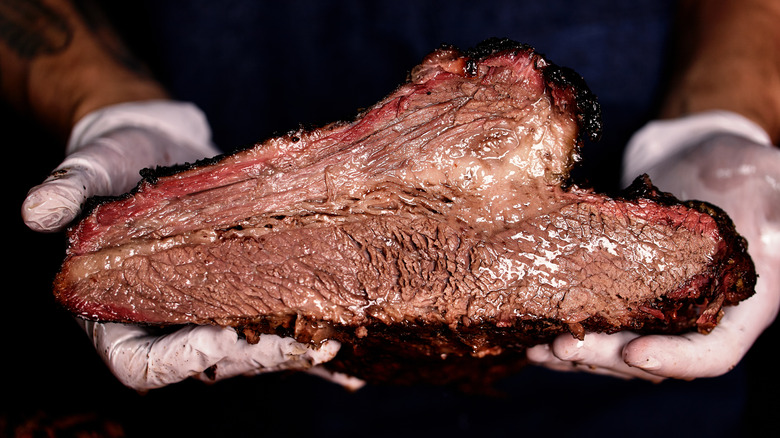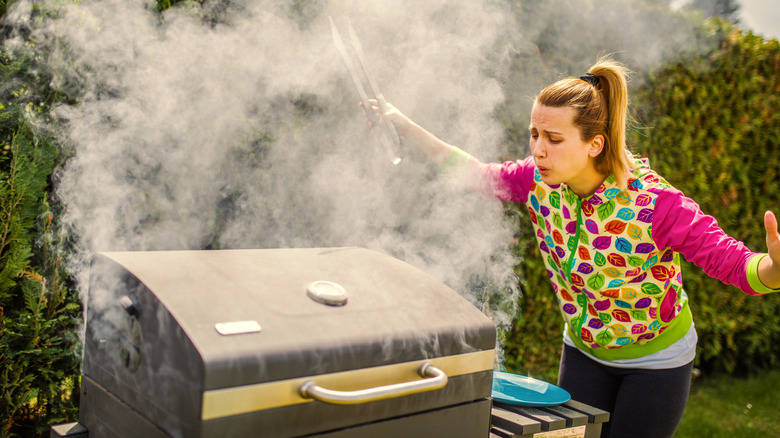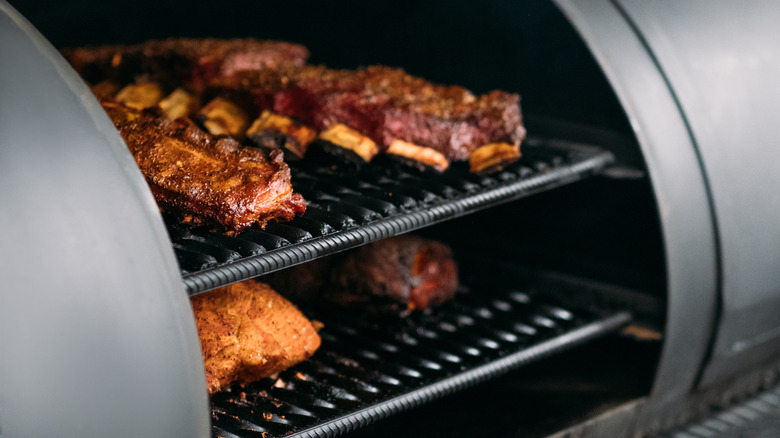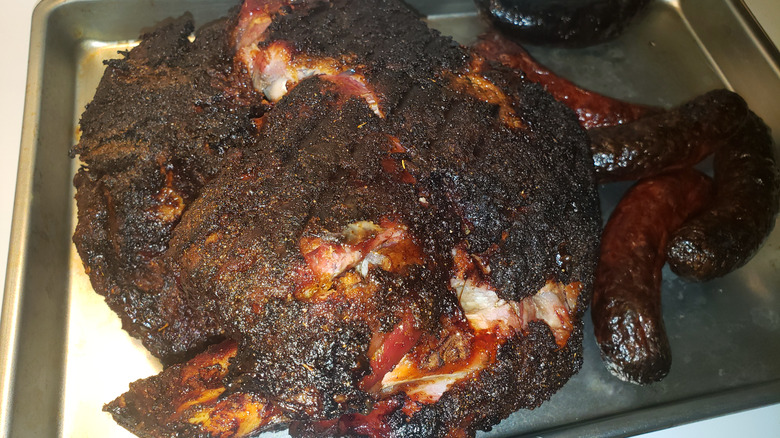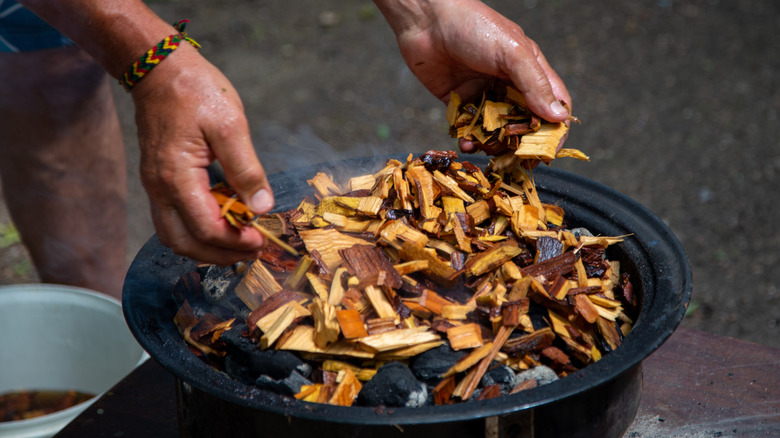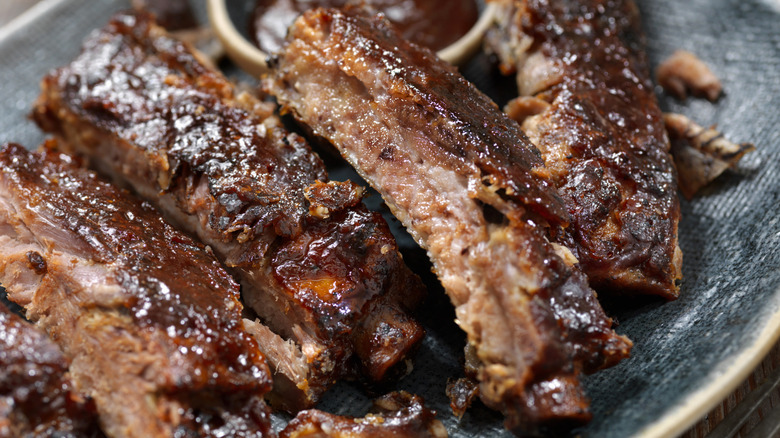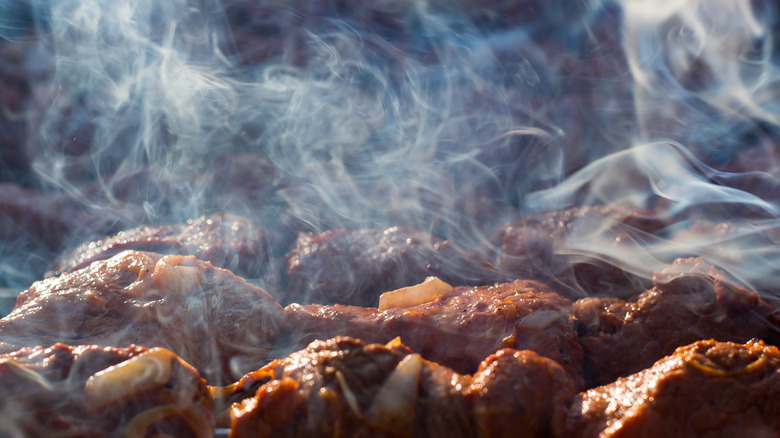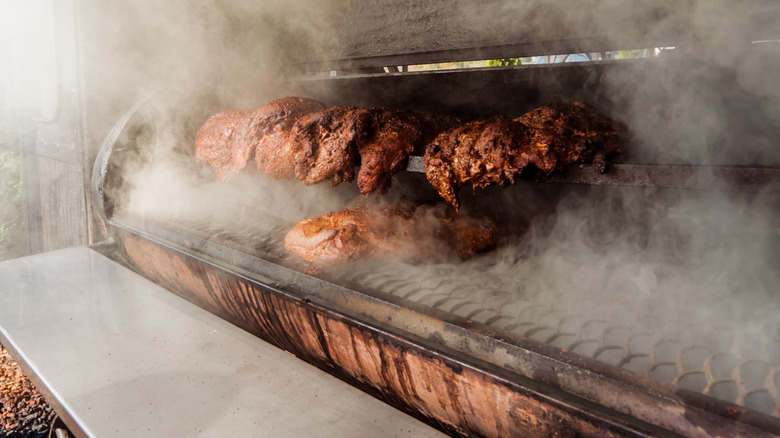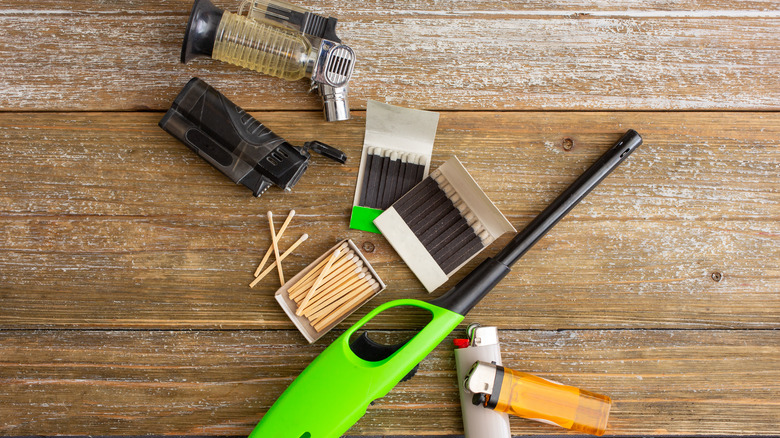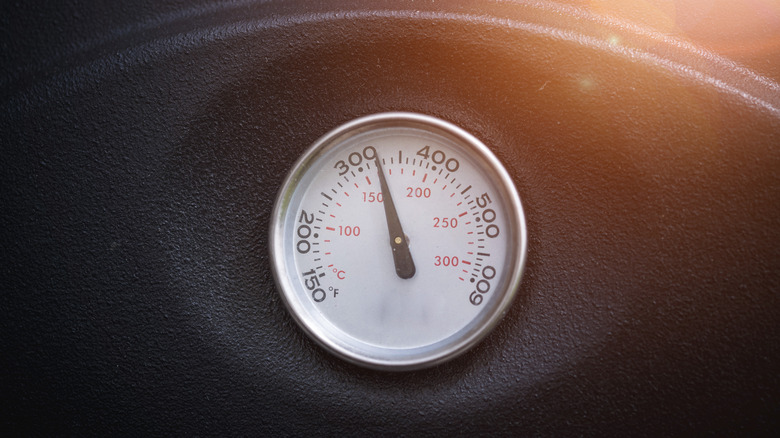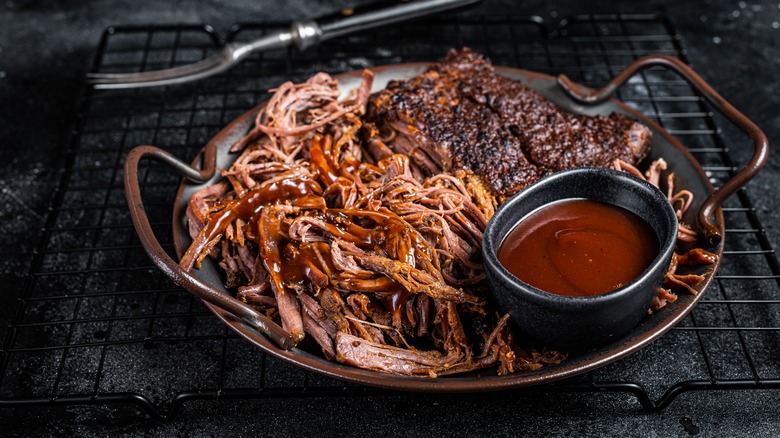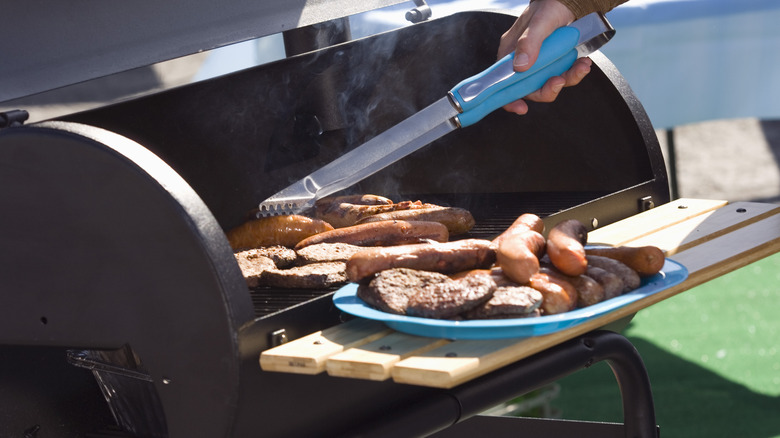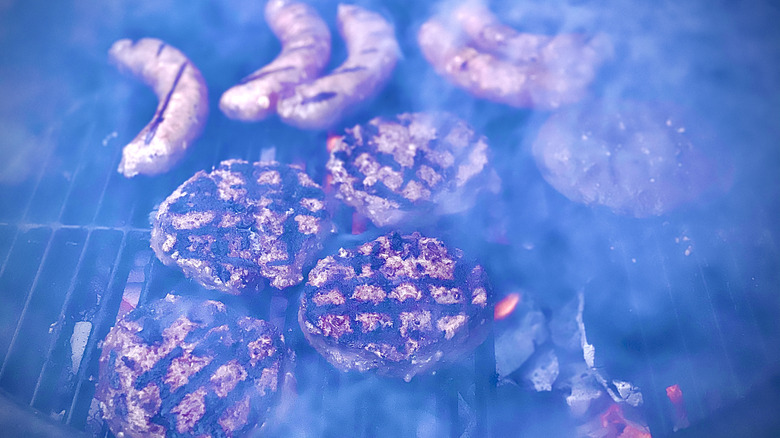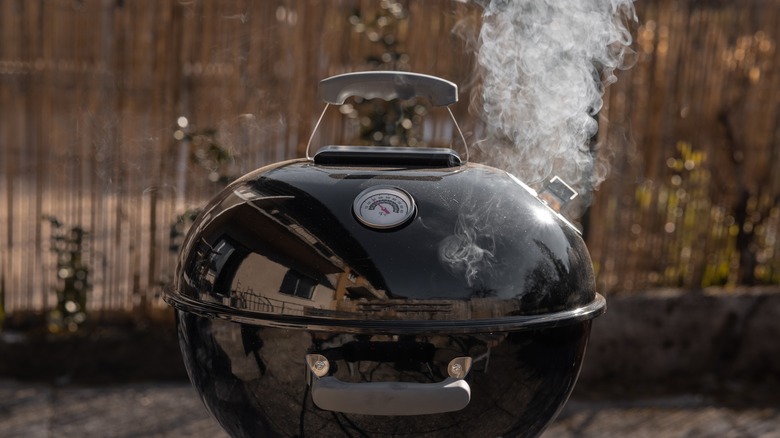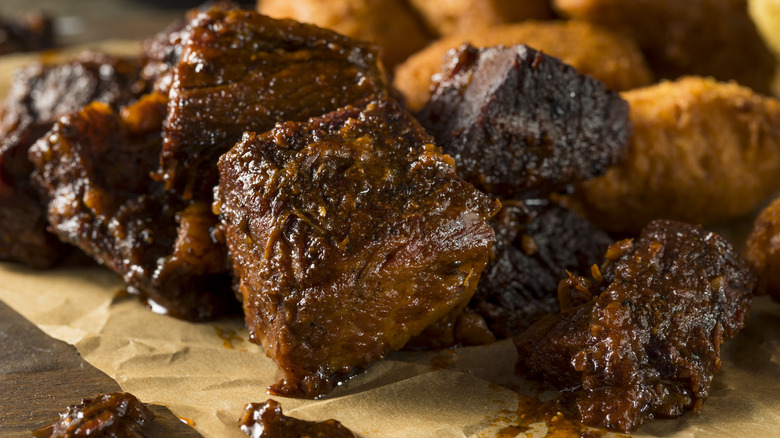14 Mistakes Everyone Makes When Smoking Meat
For as long as people have been cooking meat, they've been smoking it. This method of preparing animal protein has likely been around since the very invention of cooking itself, with prehistoric cave-dwelling humans practicing the technique. Smoking meat, both then and now, worked as a preservation technique, making the food last longer, as well as adding flavor, but it can be tricky too.
Since those early days, though, smoking meat has come a long way, and you now order smoky beef, pork, and chicken in barbecue joints and gourmet restaurants alike. As well as this, smoking is also a popular method of cooking for home chefs, and with a smoker, some wood chips, and a little bit of patience, it's entirely possible to prepare succulent, fall-off-the-bone cuts in your back garden. That doesn't mean it's easy, though. Smoking is a technique that needs to be mastered, and there are plenty of pitfalls on the way to the perfect smoked brisket that too many chefs fall into. Whether it's picking the wrong type of wood, trying to speed up the smoking process, messing up your timings, or using the wrong materials, we've got the scoop on everything you need to avoid right here.
1. Using too much smoke
It doesn't take a Nobel Prize to figure out that smoking meat requires... wait for it... smoke! How much smoke you need to use, though, is a different question entirely -– and more smoke doesn't equal better meat. Using too much smoke can give your meat a bitter flavor, which is created by a compound called creosote, made when your wood burns, moving through your smoking chamber. When your smoker doesn't have good airflow, or the air circulation around your fire isn't good enough, the smoke in the chamber builds up and the creosote condenses, eventually settling into your meat.
This is especially likely to happen with charcoal burners, as they're more prone to produce black smoke, which can build up in your chamber. The best solution is to ensure you're only smoking when it becomes thin and blue, and that you have a constant airflow through your chamber. If your food has become over-smoked, there are a few fixes you can perform. Scraping off the bark on your meat will help to reduce the bitter flavor, although bear in mind that it will also reduce the overall flavor of your food. You can also try to balance out the flavors by adding a sweet glaze to the outside of your meat.
2. Trying to smoke meat too quickly
Smoking is a method that requires a lot of time and patience — way more than you think. Because your meat cooks and gains its flavors via indirect heat, it can take a while for the smoke to warm it up to the point that it's cooked enough, as well as for all those smoky tastes to develop. It can be very tempting to think you can speed things up, or follow recipes that promise a complex flavor in just a few hours. However, it's simply not possible.
Instead, you must leave enough time for your meat to cook slowly, allowing with extra time for contingency. Remember that some cuts, like beef brisket, can take up to 20 hours to smoke fully, and that's not even accounting for resting time. If you want a quick result, it's better to pick types of meat that smoke more quickly, like sausages, chicken thighs, or chicken wings. Opting for fish can also be a great choice for the time-pressured folks out there, as its flakier, more porous flesh allows it to cook and gain flavor faster.
3. Smoking the wrong cut of meat
Just as you can't build a solid house on a shaky foundation, you also can't get the best meal possible with the wrong ingredients. This is especially true when you're smoking meat, so you should be careful what you choose. Cuts of meat that are especially lean and high in protein may be good for some meals, but they suffer when smoking, as the low-and-slow cooking process can tend to dry them out and leave them tough. Expensive cuts should also be saved for another meal, when you can fully enjoy their natural flavors, instead of having them altered by smoke.
Somewhat pleasingly, the best cuts to choose for smoking tend to be cheaper, with a higher fat content. This fat helps keep the meat moist as it slowly cooks and gelatinizes into silky, juicy deliciousness. Shoulder, butt, and ribs are all great options for pork, whereas brisket and chuck are ideal if you're going for beef. If you're smoking poultry, choosing thighs or full joints can help to keep things moist, although you can certainly smoke lean chicken and turkey breasts if you wish. You just need to keep the temperature low, to avoid it getting too dry and chewy.
4. Assuming all wood chips give the same result
Your choice of wood chips is one of the biggest factors in the eventual flavor of your smoked meat. It's way too easy, though, not to think about the type you're choosing at all, and simply go with the first you see. Doing this can leave your meat with a pretty weird flavor. Opting for a fruit wood like peach or apple, for example, will give your meat a lighter, sweeter, more floral flavor, which is largely unsuitable for red meats like beef or lamb. A woodier, more mellow option like hickory, pecan, or mesquite, on the other hand, will flavor white meat or fish too aggressively and take away any delicacy or subtlety you were trying to achieve.
It's important to think about the overall flavor profile of your final meal and work backward from there, picking wood chips that correspond with these desired notes. If you want a good middle ground, oak and cherry wood are good options, thanks to their relative neutrality. Other fruit woods tend to be better for poultry or fish, and darker woods should be reserved for red meat and heavy cuts. Don't forget that it's entirely possible to mix wood chips and make your own flavor combination — try mixing oak with apple, for example, for a sweet result that has an undertone of woodiness.
5. Adding too much sauce to your meat
All barbecue enthusiasts know the importance of sauce as a way to intensify the meat's flavor and provide an important counterbalance of sweetness. Unfortunately, adding too much to smoked meat is a great way to completely ruin your hard work. Smoking meat floods it with complex, layered flavors, and adding too much sauce can overpower it, making it overly sweet. It can also ruin the texture of your meat's bark, turning a pleasingly crispy exterior into something gummy and syrupy.
You should always be sparing with your sauce, adding just a few light coats at most to your meat. If you're smoking ribs, try not to use more than a ¼ cup per rack, with slightly more if your cut's especially thick. You should also be careful about when you add your sauce. Make sure to only daub it on about 15 minutes before you're ready to pull your meats out of the smoker. Otherwise, the sugars in the sauce can burn, destroying your meat's flavor at the very last moment. If you know you're catering to a group of friends that lay their sauce on thick, serve it on the table, so they can add as much as they want (after they've complimented your delicately-smoked meat, of course).
6. Putting your meat in the smoker too early
Because smoking takes way longer to cook meat than other methods, it's natural to want to get started as soon as possible. This can lead some people to put their meat in pretty much immediately after they light their charcoal. However, this is a surefire way to ruin your food, thanks to the type of smoke produced upon first lighting it. "Don't add the meat early on when the smoker is bellowing tons of heavy smoke. The heavy smoke is considered 'dirty' smoke, which will cause the meat to become more bitter," explains Certified Angus Beef chef and Kansas City Barbecue Society Judge Michael Ollier in an interview with AllRecipes.
Once that bitter flavor has infused into your meat, it's hard to get it out without cutting off its outside layers. Instead, you should wait it out and let your smoke develop. After you light your smoker, give it around 15 to 20 minutes to settle. This will allow the temperature to stabilize, preventing any unexpected flare-ups and allowing the smoke to turn from thick, black plumes to a wispier blue appearance.
7. Using a fire that's too big
Starting your fire is one of the most exciting moments of the smoking process — but don't go overboard. Being too heavyhanded with your wood, charcoal, or kindling can lead to you making a fire that's way too large. When you do this, it makes everything much harder to control and the temperature can rise unexpectedly, leading to a change in smoke and a burnt flavor in your meat.
It's way better to go small, advises pitmaster Melissa Cookston. "A smaller, clean-burning fire is much preferred to a larger amount of fuel that you will have to keep 'choked down' with your air intakes, or worse, squirted with the spray bottle," Cookston said in an interview with Food & Wine. If you're using a wood smoker, using four pieces of wood roughly 2 to 3 inches in diameter should be enough to maintain a 225-degree F fire, provided that you're adding another piece of wood roughly every hour. For charcoal smokers, aim for 2 to 3 pieces of charcoal for every pound of meat to smoke at around 250 degrees F. These are, however, just approximate amounts, and the true amount you'll need will vary depending on what model of smoker you have — which is why it's always best to use a thermometer.
8. Starting your fire with lighter fluid
Using lighter fluid to get your smoker going makes sense on paper. No more trying desperately to get your wood going with flimsy kindling or misshapen logs — just splash some on and away you go. Do this, however, and you'll sacrifice the flavor of your food. When you use lighter fluid on wood or charcoal, all of its acrid chemical taste and stench will burn off in the smoke. That same smoke is the smoke that's cooking and flavoring your meat, leaving you with pork butts and beef briskets that have a strong whiff of petroleum.
It's a far better strategy to be a little patient with your fire-starting and use old-school methods. Grab some quality dry kindling at the store; make sure you get extra in case you burn through it, or if a strong wind happens to blow it out. Grabbing some paraffin wax cubes can also be a great way to start your fire. Paraffin wax cubes are non-toxic and produce a long-lasting flame, giving your wood or charcoal enough time to get started. They also remain flammable when wet, and won't be blown out by the wind.
9. Letting the temperature rise too much
When you're smoking, temperature is everything. The temperature your wood chips are smoking determines the type of smoke they produce, and this has a huge effect on your meat. Not only does the smoke itself imbue your meat with a bitter flavor, but high-temperature smoke can also affect your meat's rub, charring it and adding to the acrid flavors. This is even more likely to happen if you're using a rub with sugar in it, which will turn black, crusty, and pungent very quickly.
Allowing your smoker's temperature to rise too much can also dry out your meat, completely ruining the juiciness you're trying to create through the smoking process. To control the temperature of your wood or charcoal smoker, you need to control its fire. Avoiding adding too much fuel or building a fire that's too big is of course important, but keeping an eye on its oxygenation is vital too. As airflow increases your fire's speed, use your flue damper to limit air if your fire is getting too fierce. The fire won't die down immediately after adjusting the damper, so try to pre-empt your temperature rising by keeping an eye on your thermometer. You can also open up your firebox door to dispel some heat.
10. Relying solely on your cooking times
There are plenty of guides out there that tell you exactly how long your meat will take to cook in a smoker... and you can't rely on any of them. Okay, we're kinda joking, but it's always a good idea not to view these cooking times as the gospel truth for perfectly-smoked meat. "Every piece of meat is different. A lot of people say that it's about an hour and a half per pound of meat. While that can get you in the ballpark, you can't let that be your only guide," says pitmaster and Holy Ground partner Franco V., via Food & Wine.
Remember, those times don't necessarily account for the specific shape or dimensions of your joint, as well as its fat-to-meat ratio or amount of connective tissue. They also probably don't consider atmospheric factors like wind, rain, altitude, humidity, or air temperature, all of which can affect how long your meat will take. If your smoker is particularly well-insulated (or particularly poorly insulated), this can also affect your cooking times. The solution? A thermometer. "Get an accurate, quick read digital thermometer and when your meat hits the right temp, take it off," V. states. Make sure, though, that your probe gets to the thickest part of the meat, to get a true read of its internal temperature.
11. Checking on your meat too often
It's natural to be curious about how your meat's doing when it's being smoked, especially because the process takes such a long time. Opening up the lid to check on it too much, however, diffuses the amount of smoke in your smoker or grill, in turn diffusing the amount of flavor your food takes on. Opening things up also lets your built-up heat out, messing up your timings and ruining how evenly your meat cooks.
Instead, you'll want to leave things alone as much as possible so you can contain the smoke. That's not to say you shouldn't check it at all, though. For larger cuts of meat, it's okay to take a peek every half an hour or so, to ensure that things aren't overcooking or blackening too quickly. Smaller cuts of meat, like thin steaks, may benefit from being checked a little more often. It's also useful to start checking it a tad more frequently when you're coming to the end of your cooking time, to pull your meat out before it gets too dry. In general, though, you should trust the smoke to do its thing.
12. Not paying attention to your smoke color
Novice smokers may think that all smoke is equally good for flavoring and cooking meat. The pros, on the other hand, know that it's the color you need to watch out for. Your fire requires a steady stream of oxygen to burn properly, but when it's lacking that essential element, your smoke gets thicker and darker, turning black. This blackness makes your food taste sooty and bitter. Black smoke can also be caused by an unclean smoker, or by throwing too much wood into your smoking vessel.
The ideal color for your smoke to be is blue-white and almost transparent. To do this, you'll need to get your balance of wood quantity, temperature, and ventilation just right. Make sure you don't pack your smoker with too much wood, and grab yourself a thermometer to keep an eye on the temperature. Bear in mind that even though white smoke looks better than black smoke, it can still give your food a charred and ashy flavor, particularly if it's fast-moving or burns into plumes. Remember, you're not in a rush: The more patient you are, and the more controlled your smoking is, the better your smoke will be.
13. Forgetting to ventilate properly
When smoking meat, ventilation is everything. The amount of oxygen your fire receives has a direct impact on how hot it gets and how fiercely it burns. This oxygen usually moves into your fire from the underside of your smoker, fueling your fire, and helping to produce the smoke that billows out of the top. With improper ventilation, though, that oxygen is unable to reach your fire, starving it and lowering its temperature.
The air vents on your smoker or grill will be adjustable, and the degree at which you need to open and close them will likely take a bit of trial and error. Just remember that when it comes to changing up the airflow, it's the bottom vents that are far more important. You should also periodically check them for any blockages, which can occur pretty quickly due to ash falling from the fire. Giving them a wiggle every half an hour or so (making sure to re-adjust them to the same setting) will help any ash fall through. Make sure you're cleaning your air vents fully after any smoking session, too, and regularly check your cooking chamber and fireboxes for any air leaks, which may increase ventilation more than you'd like.
14. Forgetting to rest your meat after it's smoked
Because smoking is such a lengthy process, you're probably not going to wait much longer to eat after your meat is cooked. However, we would heavily suggest you hold off a bit more than you think. Resting your meat allows all of the juices that have been squeezed to the surface to soak slowly back in, keeping the meat moist and stopping it from escaping when you slice into it. Giving large pieces of meat like pork butts time to rest also helps finish their cooking process via residual heat, preventing them from being tough when you try to shred them.
As a general rule, the larger your meat is, the longer you'll need to rest it. For big hunks of meat, like butts or whole chickens or turkeys, they may need a few hours of resting before they're ready to go, although you might be able to get away with resting them for just 30 minutes. Placing your meat in an insulated box, after wrapping it in tin foil will help it to stay warm while it rests. There isn't necessarily a maximum amount of time you should rest your meat, but bear in mind that it will continue to cool even when insulated, so take that into consideration as well.
